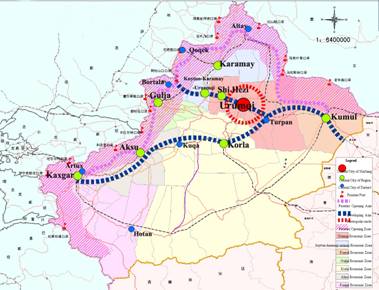| Research Divisions |
 |
| Location: Home > Research > Research Divisions > Department of Human-Earth System and Regional Development |
| Department of Human-Earth System and Regional Development |
|
Research Fields (1) Regional sustainable development (2) Agricultural and rural geography (3) Urban geography and urban planning (4) Development and protection of tourism resources, and tourism planning (4) Theory and evaluation methods for environmental influences Significant Projects (1) Urban system planning of Xinjiang (supported by the Department of Construction of Xinjiang, 0.3 million yuan, 2000-2003) (2) Development strategies of Urumqi’s extended metropolitan regions (supported by the Department of Construction of Xinjiang, 0.1 million yuan, 2003-2005) (3) Research into dividing the main functional district in Xinjiang (supported by the Xinjiang Development and Reform Commission, 2 million yuan, 2006-2008) (4) Research on strategy for regional economic cooperation and ecological safety of resources in Central Asia-scientific research on Altay Natural Heritage (supported by the Knowledge Innovation Project of the CAS, 0.35 million yuan, 2005-2008) (5) Research on public road environmental protection in the arid zone, taking National Highway 315 section as an example (supported by the Science and Technology Project of Western China, 0.3 million yuan, 2005-2006) Major Achievements (1) Theory and practice of urban system in Xinjiang The research links the urban system planning with theory and practice. Its main finding is that the spatial framework of an urban system can reflect on regional economic development. The research received a Science and Technological Progress award in 2005. Main Publication Zhang X L, Li C H, Du H R, et al. 2006. Theory and Practice of Urban System in Xinjiang. Urumqi: Xinjiang People Publishing House.
Spatial framework of Urumqi’s metropolis circle (2) Research on riparian ecology in the arid zone, taking the middle region of the Tarim River of Xinjiang as an example The research found that the river corridor in the middle and lower reaches of the Tarim River is divided into three main functional zones of 1andscape ecology, whose features are analyzed, and some measures were put forward for the ecological protection in the middle and lower reaches of the Tarim River. Main Publication Zhou H R. 2007. Research on Riparian Ecology in the Arid Zone, Taking the Middle Region of the Tarim River of Xinjiang as an Example. Beijing: Science Press. (3) Tourism development theories and case studies of Xinjiang The research, led by YANG Zhaoping, focused an initial systemic study on tourism destinations in the Border Minorities regions and explained the characteristics, dynamic mechanism and the spatial structure of regional tourism in Xinjiang. The research received a Science and Technological Progress award in 2009.
Distribution map of tourism areas in Xinjiang (4) Regional structure and spatial morphology characteristics of oasis urban agglomeration in arid areas The authors recommended that development of citys’ economies should be strengthened, and more attention should be paid to regional planning in the process of urban agglomeration. Main Publication Zhang Y F, Yang D G, Zhang X H, et al, 2009. Regional structure and spatial morphology characteristics of oasis urban agglomeration in arid area—A case of urban agglomeration in northern slope of Tianshan Mountains, Northwest China. Chinese Geographical Science, 19(4): 341-348.
Spatial structure of Xinjiang Personnel There are 20 research staffs in the department, including 7 professors and 6 associate professors. There are currently 41 postgraduate students in the department, including 21 PhD candidates and 20 MSc candidates. Contact Tel: +86-991-7885346, 7885349 Director: Prof. YANG Degang E-mail: dgyang@ms.xjb.ac.cn Deputy Director: Dr. DU Hongru E-mail: duhr@ms.xjb.ac.cn |
| Back |


